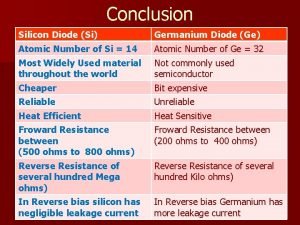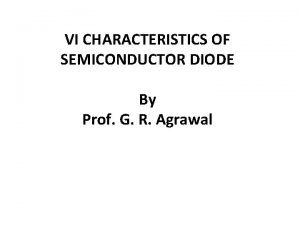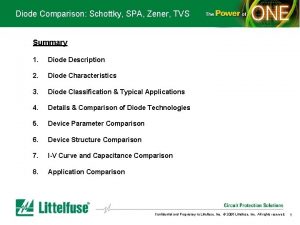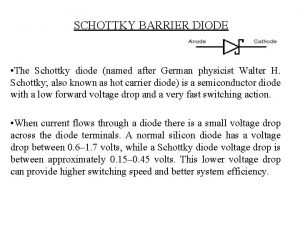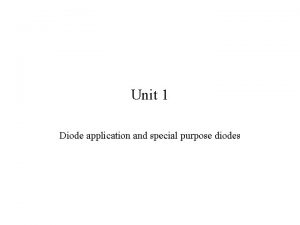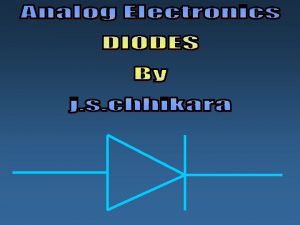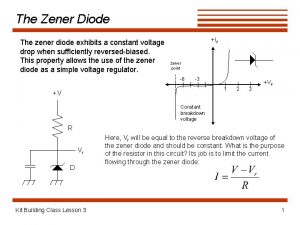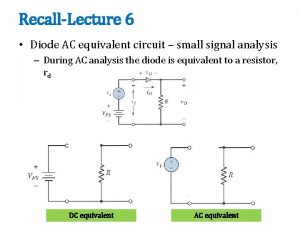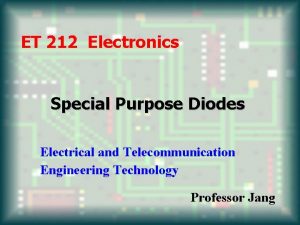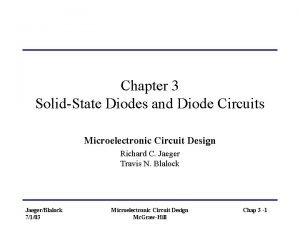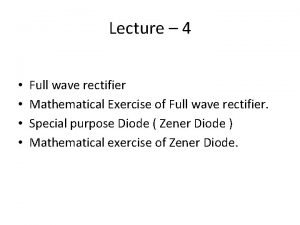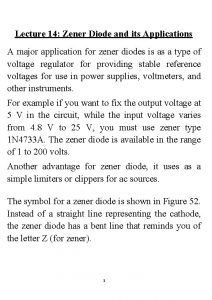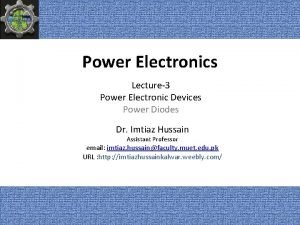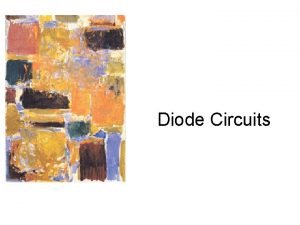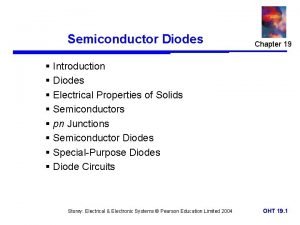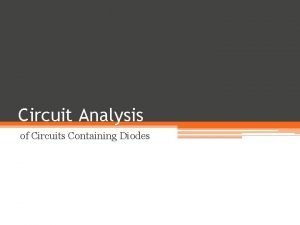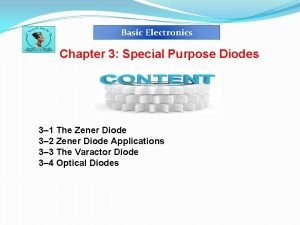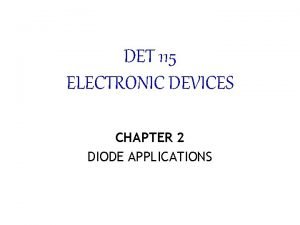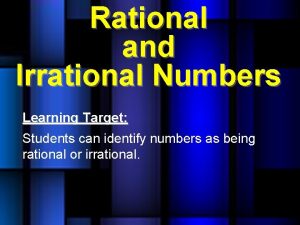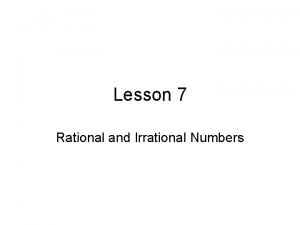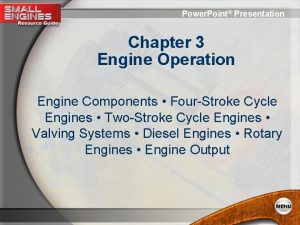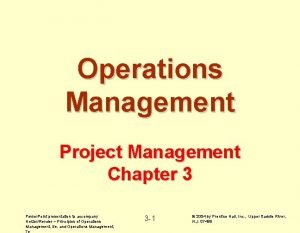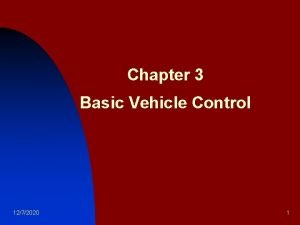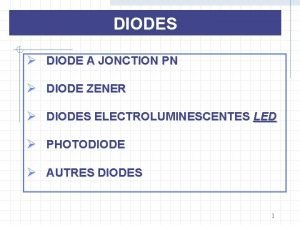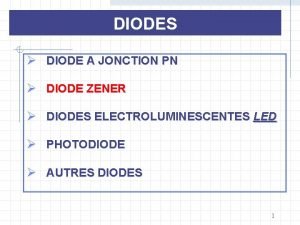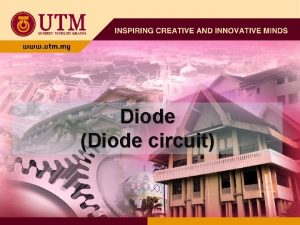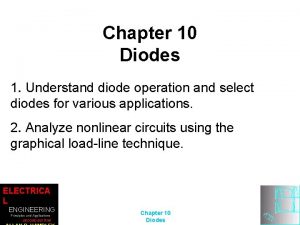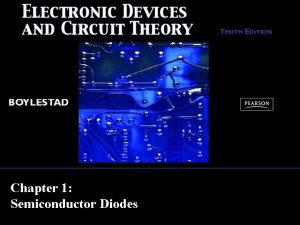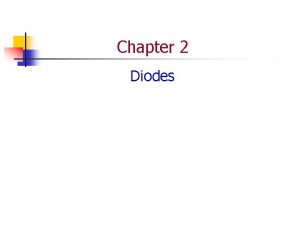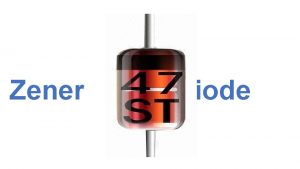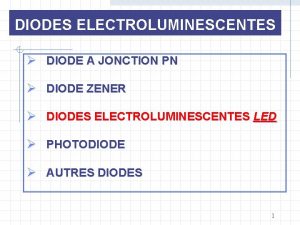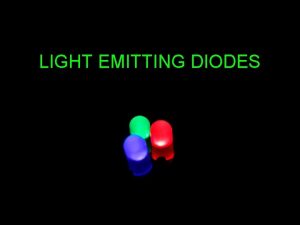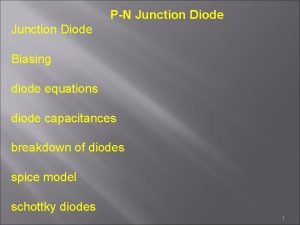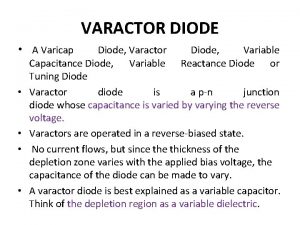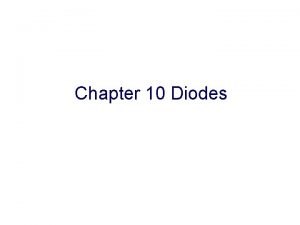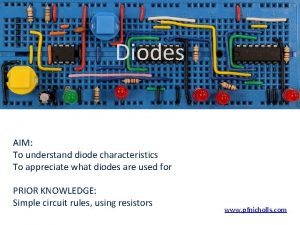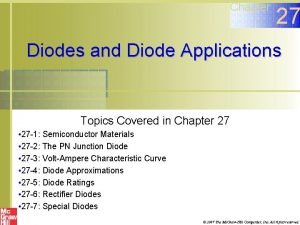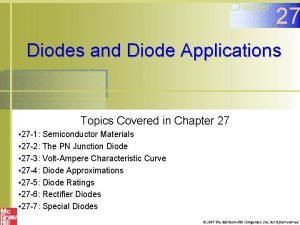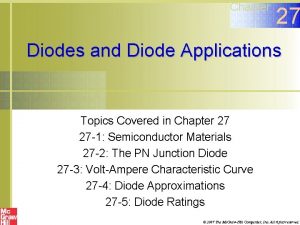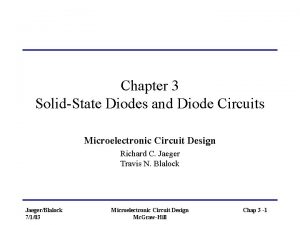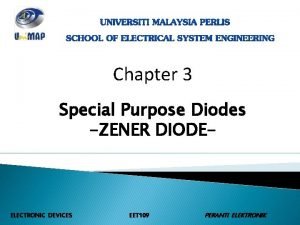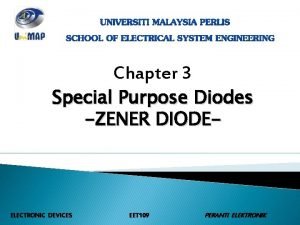Chapter 2 Diodes 1 Understand diode operation and














































- Slides: 46

Chapter 2 Diodes 1. Understand diode operation and select diodes for various applications. 2. Analyze nonlinear circuits using the graphical load-line technique. 3. Analyze and design simple voltage-regulator circuits. 4. Solve circuits using the ideal-diode model and piecewise-linear models. 5. Understand various rectifier and wave-shaping circuits. 6. Understand small-signal equivalent circuits.

2. Diodes – Basic Diode Concepts 2. 1. 1 Intrinsic Semiconductors * Energy Diagrams – Insulator, Semiconductor, and Conductor the energy diagram for the three types of solids 2

2. Diodes – Basic Diode Concepts 2. 1. 1 Intrinsic Semiconductors * Intrinsic (pure) Si Semiconductor: Thermal Excitation, Electron-Hole Pair, Recombination, and Equilibrium 3

2. Diodes – Basic Diode Concepts 2. 1. 1 Intrinsic Semiconductors *Apply a voltage across a piece of Si: electron current and hole current 4

2. Diodes – Basic Diode Concepts 2. 1. 2 N- and P- Type Semiconductors * Doping: adding of impurities (i. e. , dopants) to the intrinsic semiconductor material. * N-type: adding Group V dopant (or donor) such as As, P, Sb, … 5

2. Diodes – Basic Diode Concepts 2. 1. 2 N- and P- Type Semiconductors * Doping: adding of impurities (i. e. , dopants) to the intrinsic semiconductor material. * P-type: adding Group III dopant (or acceptor) such as Al, B, Ga, … 6

2. Diodes – Basic Diode Concepts 2. 1. 3 The PN-Junction * The interface in-between p-type and n-type material is called a pn-junction. 7

2. Diodes – Basic Diode Concepts 2. 1. 4 Biasing the PN-Junction * There is no movement of charge through a pn-junction at equilibrium. * The pn-junction form a diode which allows current in only one direction and prevent the current in the other direction as determined by the bias. 8

2. Diodes – Basic Diode Concepts 2. 1. 4 Biasing the PN-Junction *Forward Bias: dc voltage positive terminal connected to the p region and negative to the n region. It is the condition that permits current through the pn-junction of a diode. 9

2. 1. 4 Biasing the PN-Junction *Forward Bias: dc voltage positive terminal connected to the p region and negative to the n region. It is the condition that permits current through the pn-junction of a diode. 10

2. Diodes – Basic Diode Concepts 2. 1. 4 Biasing the PN-Junction *Forward Bias: 11

10. Diodes – Basic Diode Concepts *Reverse Bias: dc voltage negative terminal connected to the p region and positive to the n region. Depletion region widens until its potential difference equals the bias voltage, majority-carrier current ceases. 12

2. Diodes – Basic Diode Concepts *Reverse Bias: majority-carrier current ceases. * However, there is still a very small current produced by minority carriers. 13

2. Diodes – Basic Diode Concepts 2. 1. 4 Biasing the PN-Junction * Reverse Breakdown: As reverse voltage reach certain value, avalanche occurs and generates large current. 14

2. Diodes – Basic Diode Concepts 2. 1. 5 The Diode Characteristic I-V Curve 15

2. Diodes – Basic Diode Concepts 2. 1. 6 Shockley Equation * The Shockley equation is a theoretical result under certain simplification: 16

2. Diodes – Load-Line Analysis of Diode Circuits 2. 2 Load-Line Analysis of Diode Circuit 17

2. Diodes – Load-Line Analysis of Diode Circuits Example 2. 1 - Load-Line Analysis 18

2. Diodes – Load-Line Analysis of Diode Circuits Example 2. 2 - Load-Line Analysis 19

2. Diodes – Zener Diode Voltage-Regulator Circuits 2. 3 Zener-Diode Voltage-Regulator Circuits 2. 3. 1 The Zener Diode * Zener diode is designed for operation in the reverse-breakdown region. * The breakdown voltage is controlled by the doping level (-1. 8 V to 200 V). * The major application of Zener diode is to provide an output reference that is stable despite changes in input voltage – power supplies, voltmeter, … 20

2. Diodes – Zener-Diode Voltage-Regulator Circuits 2. 3. 2 Zener-Diode Voltage-Regulator Circuits * Sometimes, a circuit that produces constant output voltage while operating from a variable supply voltage is needed. Such circuits are called voltage regulator. * The Zener diode has a breakdown voltage equal to the desired output voltage. * The resistor limits the diode current to a safe value so that Zener diode does not overheat. 21

2. Diodes – Zener-Diode Voltage-Regulator Circuits Example 2. 3 – Zener-Diode Voltage-Regulator Circuits Actual Zener diode performs much better! 22

2. Diodes – Zener-Diode Voltage-Regulator Circuits 2. 3. 3 Load-Line Analysis of Complex Circuits * Use the Thevenin Equivalent 23

2. Diodes – Zener-Diode Voltage-Regulator Circuits Example 2. 4 – Zener-Diode Voltage-Regulator with a Load 24

2. Diodes – Zener-Diode Voltage-Regulator Circuits Exercise 2. 5 25

2. Diodes – Ideal-Diode Model 2. 4 Ideal-Diode Model * Graphical load-line analysis is too cumbersome for complex circuits, * We may apply “Ideal-Diode Model” to simplify the analysis: (1) in forward direction: short-circuit assumption, zero voltage drop; (2) in reverse direction: open-circuit assumption. * The ideal-diode model can be used when the forward voltage drop and reverse currents are negligible. 26

2. Diodes – Ideal-Diode Model 2. 4 Ideal-Diode Model * In analysis of a circuit containing diodes, we may not know in advance which diodes are on and which are off. * What we do is first to make a guess on the state of the diodes in the circuit: 27

2. Diodes – Ideal-Diode Model Example 2. 5 – Analysis by Assumed Diode States 28

2. Diodes – Ideal-Diode Model Exercise * Find the diode states by using ideal-diode model. Starting by assuming both diodes are on. 29

2. Diodes – Piecewise-Linear Diode Models 2. 5. 1 Modified Ideal-Diode Model * This modified ideal-diode model is usually accurate enough in most of the circuit analysis. 30

2. Diodes – Piecewise-Linear Diode Models 2. 5. 2 Piecewise-Linear Diode Models 31

2. Diodes – Rectifier Circuits 2. 6 Rectifier Circuits * Rectifiers convert ac power to dc power. * Rectifiers form the basis for electronic power suppliers and battery charging circuits. 10. 6. 1 Half-Wave Rectifier 32

2. Diodes – Rectifier Circuits * Battery-Charging Circuit * The current flows only in the direction that charges the battery. 33

2. Diodes – Rectifier Circuits * Half-Wave Rectifier with Smoothing Capacitor * To place a large capacitance across the output terminals: 34

2. Diodes – Rectifier Circuits 2. 6. 2 Full-Wave Rectifier Circuits * Center-Tapped Full-Wave Rectifier – two half-wave rectifier with out-ofphase source voltages and a common ground. * When upper source supplies “+” voltage to diode A, the lower source supplies “-” voltage to diode B; and vice versa. * We can also smooth the output by using a large capacitance. 35

2. Diodes – Rectifier Circuits 2. 6. 2 Full-Wave Rectifier Circuits * The Diode-Bridge Full-Wave Rectifier: A, B C, D 36

2. Diodes – Wave-Shaping Circuits 2. 7. 1 Clipper Circuits * A portion of an input signal waveform is “clipped” off. 37

2. Diodes – Wave-Shaping Circuits 2. 7. 2 Clamper Circuits * Clamp circuits are used to add a dc component to an ac input waveform so that the positive (or negative) peaks are “clamped” to a specified voltage value. 38

2. Diodes – Linear Small-Signal Equivalent Circuits 2. 8 Linear Small-Signal Equivalent Circuits * In most of the electronic circuits, dc supply voltages are used to bias a nonlinear device at an operating point and a small signal is injected into the circuits. * We often split the analysis of such circuit into two parts: (1) Analyze the dc circuit to find operating point, (2) Analyze the small signal ( by using the “linear smallsignal equivalent circuit”. ) 39

2. Diodes – Linear Small-Signal Equivalent Circuits 2. 8 Linear Small-Signal Equivalent Circuits * A diode in linear small-signal equivalent circuit is simplified to a resistor. * We first determine the operating point (or the “quiescent point” or Q point) by dc bias. * When small ac signal injects, it swings the Q point slightly up and down. * If the signal is small enough, the characteristic is straight. 40

2. Diodes – Linear Small-Signal Equivalent Circuits 2. 8 Linear Small-Signal Equivalent Circuits 41

2. Diodes – Linear Small-Signal Equivalent Circuits 2. 8 Linear Small-Signal Equivalent Circuits * By using these two equations, we can treat diode simply as a linear resistor in small ac signal analysis. * Note: An ac voltage of fixed amplitude produces different ac current change at different Q point. 42

2. Diodes – Linear Small-Signal Equivalent Circuits 2. 8 Linear Small-Signal Equivalent Circuits 43

2. Diodes – Linear Small-Signal Equivalent Circuits Voltage-Controlled Attenuator * The function of this circuit is to produce an output signal that is a variable fraction of the ac input signal. * Two large coupling capacitors: behave like short circuit for ac signal and open circuit for dc, thus the Q point of the diode is unaffected by the ac input and the load. 44

2. Diodes – Linear Small-Signal Equivalent Circuits Voltage-Controlled Attenuator 45

2. Diodes – Linear Small-Signal Equivalent Circuits 0 Exercise Voltage-Controlled Attenuator 46
 To understand recursion you must understand recursion
To understand recursion you must understand recursion Ge diode characteristics
Ge diode characteristics How is zener diode different from pn junction diode
How is zener diode different from pn junction diode Zener vs schottky
Zener vs schottky Diode i-v characteristics
Diode i-v characteristics Diodes
Diodes State any two special purpose diodes
State any two special purpose diodes What are diodes made of
What are diodes made of Zener diode
Zener diode Small signal analysis diode
Small signal analysis diode Et 212
Et 212 Diode current flow
Diode current flow Full wave rectifier 4 diodes
Full wave rectifier 4 diodes Zener diodes applications
Zener diodes applications Diode symbol
Diode symbol Diode vt
Diode vt Voltmeter simbol
Voltmeter simbol Introduction to diodes
Introduction to diodes Circuit analysis with diodes
Circuit analysis with diodes Special purpose diodes
Special purpose diodes Linux operation and administration chapter 8
Linux operation and administration chapter 8 Operations and productivity chapter 1
Operations and productivity chapter 1 In generators the welding current is produced on the ____.
In generators the welding current is produced on the ____. Line regulation
Line regulation History helps us understand people and societies
History helps us understand people and societies Understand quran and salah the easy way
Understand quran and salah the easy way Understand quran and salah the easy way
Understand quran and salah the easy way Words images objects qualitative or quantitative
Words images objects qualitative or quantitative Bce to bc
Bce to bc Understand quran and salah the easy way
Understand quran and salah the easy way Quran for beginners lesson 1
Quran for beginners lesson 1 Www.understandquran.com
Www.understandquran.com Www.understandquran.com in english
Www.understandquran.com in english How to understand and apply the old testament
How to understand and apply the old testament Contextualizing in reading
Contextualizing in reading Understanding quran and salah the easy way
Understanding quran and salah the easy way Real number
Real number Whats an irrational number
Whats an irrational number Learning points examples
Learning points examples And understand
And understand How to understand graphs and charts
How to understand graphs and charts Engine operation chapter 3 test 1
Engine operation chapter 3 test 1 Operations management chapter 3 solutions
Operations management chapter 3 solutions Operation strategy example
Operation strategy example Chapter 5 principles of engine operation
Chapter 5 principles of engine operation Chapter 3 basic vehicle control worksheet answer key
Chapter 3 basic vehicle control worksheet answer key Objectives of operations
Objectives of operations

